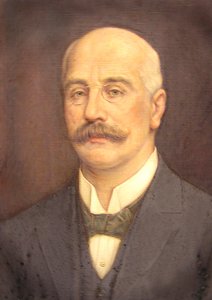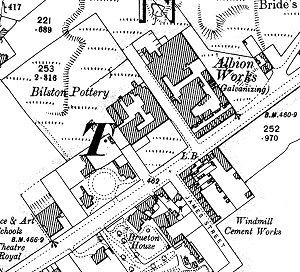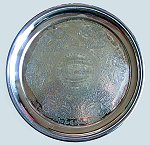1. Walter S. Bradley and the Founding of the Company The main, practically the only, source of information about the origins and early days of Bradley’s is a write up of the firm’s founder, Walter S. Bradley, which appeared in the Birmingham Gazette on 16th September 1908. (It was No. 80 in a series on “Midland Captains of Industry”).
It was a time of industrial boom in the UK and the hollowware trade was expanding. Father and son had seen an opportunity. Boom, of course, was followed, if not by bust, by depression; and the Birmingham Gazette notes that "foreigners ...Germans, Spaniards and Americans alike" had taken up the trade and had done so behind high tariff walls; and countries like Denmark and Australia were becoming self sufficient. The Gazette noted that “American watering cans are often sold in the Midlands at a less figure than they can be produced in the immediate homeland of the English industry”. According to one of Mary Southall's typescript histories Walter S. Bradley "purchased a plot of land upon which stood some cottages, in an area called Mount Pleasant in Bilston. This was in 1872. Mr. Bradley brought workmen skilled in the craft of hollow-ware from Birmingham to work for him. They started making buckets and similar household articles, actually in the back yard!" But exactly what the company first made is not clear. In Mary Southall’s second typescript history of the firm, which is probably based on oral tradition within the firm, says that in 1872 the firm employed about 25 sheet metal workers and produced frypans, bowls and galvanised buckets. They may have started with such products and may have offered a general service in pressing, stamping and sheet metal working to other companies. But it is clear, from the earliest company catalogues available, that they quickly expanded their range to cover almost anything which could be produced in sheet metal. Mary Southall also records that “With more and more new products being introduced, in 1899 the firm became Bradley and Company Limited”. At the turn of the century changes in company law had enabled private firms to incorporate and gain the advantages of limited liability without making their financial affairs too public and very many firms became limited liability companies. The origin of the trade name "Beldray" (which later became the name of the company"), and of the logo, is given by Mary Southall in one of her typescript histories: "Mr. W. S. Bradley had two sons, Hermon and Hector, and one day as the little boys were playing with their [alphabet] bricks on the hearth, their father asked them to spell out their names. One of them formed the letters "Beldray" and so the famous trade mark was born. At the works next day Mr. W. S. Bradley proudly told his work people of the new name, offering a prize to anyone who came up with a design for a suitable motif to go with the name. The winning design was of a bell on a dray". This is a charming story and may well be right as to the name although, as Hermon was about 6 years older than Hector, perhaps he was just helping out his little brother. So if Hector is about 4 years old at the time, the date would be 1895. Yet the "dray" on the logo is clearly a motor lorry of a style that must be post 1918. It seems that there must have been an earlier version of the logo, showing a horse drawn dray; but it has never been seen.
The Gazette records that, to meet foreign competition, Walter Bradley expanded from hollowware into iron stampings, tank making and the manufacture of sanitary ware. "Even recently Mr. Bradley opened up a branch in art metal work and this has now grown to considerable dimensions". This suggests a date, also suggested elsewhere, of about 1903 for the introduction of these brass and copper wares. That makes Bradley's a rather late entrant into that field, but it does not preclude the possibility that some items, such as copper kettles, were made before that date as part of a general hollowware business. But by the time of the report in 1908: "In brass and copperwork Bilston productions include kettles and urns, coal scoops and letter racks, salvers and cake stands, pin trays and fern pots, flower vases and rose bowls, mirrors and plaques, and even clocks mounted in antique copper, with decorated dials and fired enamels".
The Gazette's report reads as if the company's story was one of steady expansion under the guidance of Walter Bradley. But it was not quite that straightforward. Michael Doubleday records (on the basis of his research into his family history which included conversations with many family members) a slightly different version of events:-
Harry's strictness as an employer might also be illuminated by a story told by Hermon Bradley when he was presenting a 50 years service aware to a foreman, Mr. W. Jones, in 1952. "When he was 17 I found him larking in the shop, and sacked him. The next day the works manager took him on again. I have never regretted it during his 50 years". (Birmingham Gazette, 21 March 1952). Assuming that the works manager was indeed Harry Doubleday the story says much about the two men and their relationship. Michael Doubleday continues:
In 1908 the firm is reported as employing "some hundreds of workpeople" and to have the most up-to-date plant and "steam, suction gas and electricity are variously employed as motive power". And it is said that Walter maintained a "friendly relationship" with his work people. As an instance of this the Gazette mentions that on Walter’s marriage (to “the daughter of the later Mr. Isaac Martin Lindley of Stalybridge” – her name is not mentioned) he received a presentation from the work force, as he had done on his coming of age and did on the occasion of his fiftieth birthday. Mike Doubleday finds that the marriage took place sometime in the first quarter of 1883 and his bride was Sophia Margaret Lindley. The newspaper also notes that on the death of his father, about 1898, Walter took over his interest in the "Caponfield Furnaces" and became a life director of that company. It also notes that he was a member of the Birmingham Chamber of Commerce; that he was a strong Unionist and Tariff Reformer; and that he resided at Somerset Grange, Edgbaston. He had declined invitations to enter public life and, in his limited spare time from work, "his recreations have been restricted to riding and driving and, latterly, motoring". (The "driving" referred to would have been carriage driving). By the time of this report, 1908, Walter Bradley was "assisted by his elder son, who was educated at Rossall School, and presently a younger son will be entering the firm of Bradley & Co. Ltd.". He duly did. |
||||||||||||||






